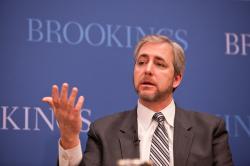Executive Summary
The geographical distribution of transportation funding revenues has become a hot issue at
both the federal and state levels.
In the last reauthorization of the federal transportation bill, numerous states and
constituencies called for a revised system of allocating states’ shares of the Highway Trust Fund–
more than 60 percent of which are generated by the federal gas tax. Some states argued that their
shares of federal transportation dollars should be proportional to the amount of gas tax revenue they
paid into the trust fund. Others wanted their shares determined by need. To a large extent both
groups of states prevailed in obtaining greater equity.
In Ohio, and some other states, state transportation dollars flow to localities on the basis of
neither of these standards for revenue distribution. The result in Ohio is a spatially skewed pattern
of state transportation spending that is essentially anti-city and even anti-suburb. In effect, funds are
diverted away from the very places that struggle with the greatest transportation needs and pay the
most in gas taxes.
This paper examines the geographic pattern of state transportation spending in Ohio
between 1980 and 1998. In particular, it examines the spatial patterns the location of state
transportation finance and spending–including current highway contracts, gas tax collections, and
vehicle registration tax revenues–and compares them to indicators of transportation demand and
need.
In doing so, the paper seeks to decipher one state’s confusing system of highway finance to
determine whether state transportation dollars are being spent in ways that meet the myriad
challenges–aging infrastructure, traffic congestion, and decentralizing economic development–
faced by metropolitan areas. In addition the paper also seeks–since Ohio’s system of
transportation finance resembles that of many states–to throw light on spending patterns within
numerous states.
To this end, this analysis of state trends and data on transportation spending from the Ohio
Department of Transportation (ODOT) and other sources finds that:
- Between 1980 and 1998, Ohio’s highway dollars were spent disproportionately in rural
counties, which received more funding relative to their transportation needs than
urban and suburban counties. One might assume that counties with high travel demands
on its roads would receive more funding to deal with the resulting wear and tear, congestion,
and other challenges to its road network. In Ohio, however, urban counties consistently took
home a smaller share of state highway funds than suburban and rural counties relative to
their amount of vehicle traffic (vehicle miles traveled), car ownership (vehicle registrations),
and demand for driving (gasoline sales). On the flipside, rural counties received more dollars
for each indicator of need than did urban or suburban counties. - At the same time, urban counties in Ohio contribute significantly more gas tax
revenues to state transportation coffers than they get back in return, and essentially
act as “donors” of transportation dollars to rural-county “donees.” Gas and vehicle
registration levies, in this regard, generate approximately 60 percent of Ohio state highway
funds. Of these revenues, a significant portion is redistributed to localities for building,
improving, and maintaining roads. But once again, urban counties fared worse than rural and
suburban counties by comparison to what they paid into the system. Highway spending in
urban and suburban counties matched neither the volume of gas tax funds generated in
those counties nor their levels of transportation need. At the federal level, the funding
inequity between “donor” and “donee” states was debated and addressed. The
Transportation Equity Act for the 21st Century (TEA-21), passed in 1998, guaranteed each
state a return of at least 90.5 percent of the share its contribution to the highway trust fund.
Despite the embrace of this funding logic at the federal level, similar rules exist neither in
Ohio nor in most other states. - These anti-urban biases arise from three principal sources. First, the formula for
distributing revenues generated from the gas and vehicle registration taxes does not favor
cities. To the contrary: Counties and townships receive these revenues in equal shares
without regard to population size, numbers of vehicles, the amount of vehicle miles traveled,
or which jurisdiction has responsibility for the roadway network. That means rural Harrison
County, with a population of 15,000 receives the same level of funding from the county share
as Cuyahoga County, home of 1.4 million urban residents. A second bias follows from the
fact state highway funds are spent on interstate highways, state roads and highways only,
which principally run through unincorporated areas, townships, and rural counties. This
generally leaves municipalities responsible for maintaining their own roadways while rural
counties benefit from greater state attention and state investment. Finally, Ohio restricts the
use of gas tax revenues to highways only, which limits the ability of urban and suburban
areas to invest in transit options or air quality improvements. That, too, tilts spending toward
rural and suburban pavement. - Overall, these spatially uneven transportation policies place a disproportionate fiscal
burden on urban jurisdictions while supporting the spread of development into
exurban and rural areas. Given the state’s funding tilts, municipalities frequently must dip
into their own funds, or impose taxes, to pay for the maintenance and improvement of their
portion of their region’s transportation network. This means local residents and businesses
wind up assuming the burdens of maintaining roads that form vital economic links for the
entire state. Compounding the problem is the fact that the state’s current spending formulas
(which favor new construction in rural areas) contribute to the spread of low-density
development in the country. Such growth patterns undermine urban and inner-suburban
jurisdictions by enabling people and businesses to locate miles from urban centers and still
benefit from metropolitan life. - To end the fiscal drag on its urban areas Ohio should reduce the bias of its
transportation funding system with a number of specific steps. The state must first fix
its tilted road classification system by including all major urban arterials in the “state highway
system” that ODOT maintains. The state should also readjust funding distribution formulas
that have clear spatial biases to better match where travel occurs, gasoline is purchased,
and where vehicle registration fees are paid. On a more basic level, Ohio should remove the
restriction that reserves gas tax revenues for highway projects only. This will require
amending the state constitution, but that is not an insurmountable hurdle. In addition, Ohio
needs to embrace transparency in its system of tax collections. Information on gas tax
collections should be released annually by the state on where motor fuels tax revenues are
generated. These data should be listed by local jurisdiction–city, township, or village–as
well as by county. In sum, Ohio’s system of highway finance should support a balanced
transportation system in order to keep Ohio cities and businesses competitive for the future.
In the end, Ohio and other states need to take a comprehensive look at how they
distribute federal and state gas taxes–the primary sources of state and local highway
funding–across their landscapes. Rural highways remain important to state road networks. But
the roads located in Ohio’s seven major metropolitan areas are especially critical to the social and
economic health of the state–and require attention. With that in mind, the emerging debate over the
reauthorization of TEA-21 offers a prime opportunity for congressional leaders to move beyond the
distribution of federal gas tax dollars across the 50 states to consider the very real donor-donee
inequities within their own states.



